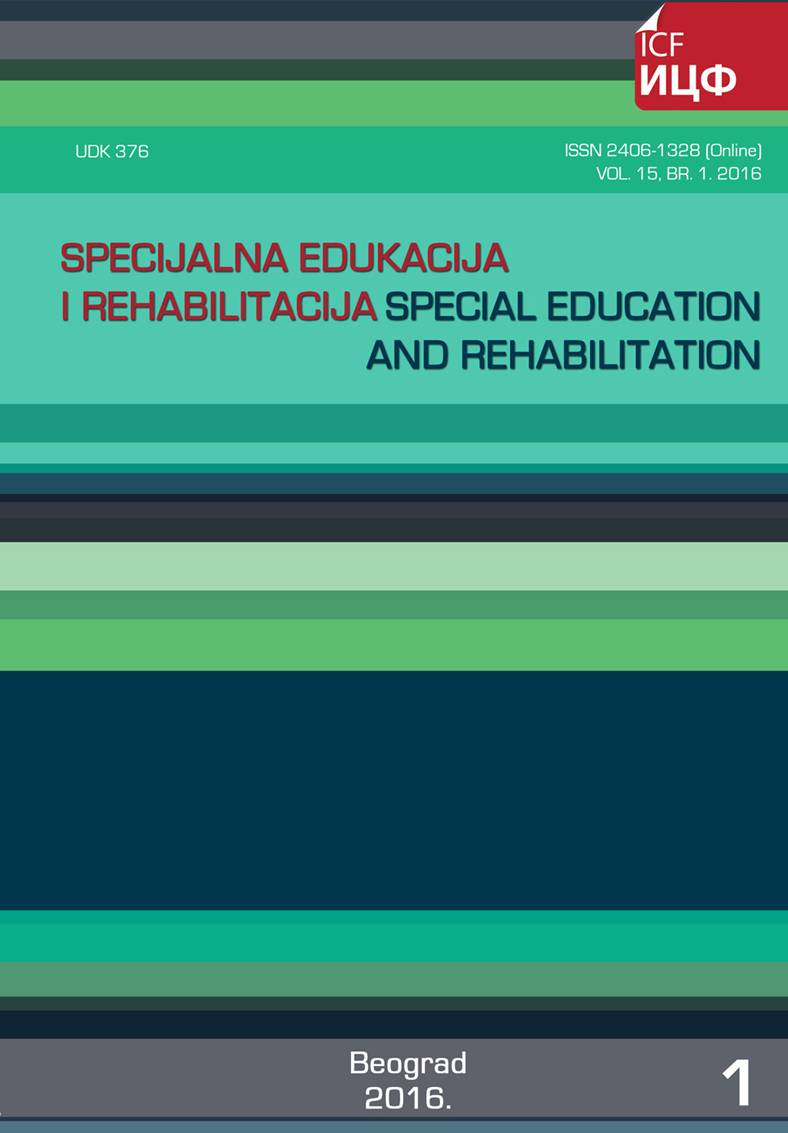UTICAJ KOMPENZACIJE PRITISKA U SREDNJEM UVU NA REGISTROVANJE DISTORZIONIH OTOAKUSTIČKIH EMISIJA
Sažetak
Cilj ovog rada bio je utvrđivanje uticaja kompenzacije pritiska u srednjem uvu na veličinu odgovora distorzionih otoakustičkih emisija (DPOAE) na frekvencijama od 1 do 6 kHz. Ispitivanje je obavljeno na 150 pacijenata, unutar pola i tri starosne grupe (2-15; 16-40; 41-71 godine). Pritisak u srednjem uvu je varirao od negativnog do pozitivnog (-329 do 195 daPa). Povećanje pritiska pri kompenzaciji za 1 daPa dovelo je do povećanja amplituda pri frekvencijama od 1.0, 1.3 i 1.6 kHz za 0,02, 0,03 i 0,02 dB SPL, a nivoa buke pri frekvencijama od 1.0 do 2.0 kHz, uslovljavajući povećanje od 0,02 do 0,03 dB SPL. Kompenzacioni tretman je doveo do povećanja odgovora DPOAE (amplituda i nivoa buke). Povećanje amplituda je bilo najveće na frekvencijama manjim od 2 kHz unutar nivoa oba ispitivana uticaja. Kompenzacija pritiska uticala je stimulativno na detektabilnost DPOAE, čime se povećava pouzdanost primene ove metode prilikom ispitivanja funkcionalnosti srednjeg uva.
Reference
Abdala, C., & Dhar, S. (2012). Maturation and aging of the human cochlea: a view through the DPOAE looking glass. Journal of the Association for Research in Otolaryngology, 13(3), 403-421. doi:10.1007/s10162-012-0319-2
Bonfils, P., & Avan, P. (1992). Distortion-Product Otoacoustic Emissions: Values for Clinical Use. Archives of Otolaryngology - Head and Neck Surgery, 118(10), 1069-1076. doi:10.1001/archotol.1992.01880100061014
Gorga, M. P., Neely, S. T., Bergman, B., Beauchaine, K. L., Kaminski, J. R., Peters, J., & Jesteadt, W. (1993). Otoacoustic emissions from normal-hearing and hearing-impaired subjects: Distortion product responses. The Journal of the Acoustical Society of America, 93(4), 2050. doi:10.1121/1.406691
Hof, J. R., Anteunis, L. J., Chenault, M. N., & Van Dijk, P. (2005). Otoacoustic emissions at compensated middle ear pressure in children. International Journal of Audiology, 44(6), 317-320. doi:10.1080/14992020500057822
Hof, J. R., De Kleine, E., Avan, P., Anteunis, L. J., Koopmans, P. J., & Van Dijk, P. (2012). Compensating for Deviant Middle Ear Pressure in Otoacoustic Emission Measurements, Data, and Comparison to a Middle Ear Model. Otology & Neurotology, 33(4), 504-511. doi:10.1097/mao.0b013e3182536d9f
Hof, J., Van Dijk, P., Chenault, M., & Anteunis, L. (2003). Otoacoustic emissions at compensated middle ear pressure: preliminary results. International Congress Series, 1254, 159-163. doi:10.1016/s0531-5131(03)01060-4
Johnson, T. A., & Baranowski, L. G. (2012). The Influence of Common Stimulus Parameters on Distortion Product Otoacoustic Emission Fine Structure. Ear and Hearing, 33(2), 239-249. doi:10.1097/aud.0b013e3182321da4
Mikić, B., Đoković, S., Sovilj, M., & Pantelić, S. (2005). Otoakustička emisija kod neonatusa, dece i odraslih, u S. Jovičić i M. Sovilj (Ur.) Otoakustička emisija, teorija i praksa (str. 122-142), Beograd: IEFPG.
Naeve, S. L., Margolis, R. H., Levine, S. C., & Fournier, E. M. (1992). Effect of ear-canal air pressure on evoked otoacoustic emissions. The Journal of the Acoustical Society of America, 91(4), 2091. doi:10.1121/1.403695
Perez, M., Delgado, R.E., & Ozdamar, O. (2011). Design of a clinically viable pneumatic system for the acquisition of pressure compensated otoacoustic emissions. Proceedings of the Annual International Conference of the IEEE Engineering in Medicine and Biology Society, EMBS, 7699-7702. doi: 10.1109/IEMBS.2011.6091897
Poling, G., Lee, J., Siegel, J., & Dhar, S. (2012). Clinical Utilisation of High-frequency DPOAEs. ENT & Audiology News, 21(4), 91-92.
Popelka, G. R., Osterhammel, P. A., Nielsen, L. H., & Rasmussen, A. N. (1993). Growth of distortion product otoacoustic emissions with primary-tone level in humans. Hearing Research, 71(1-2), 12-22. doi:10.1016/0378-5955(93)90016-t
SAS Institute Inc (2002-2010). The SAS System for Windows, Cary, NC.
Smurzynski, J., & Kim, D. (1992). Distortion-product and click-evoked otoacoustic emissions of normally-hearing adults. Hearing Research, 58(2), 227-240. doi:10.1016/0378-5955(92)90132-7
Sun, X. (2012). Ear Canal Pressure Variations Versus Negative Middle Ear Pressure: Comparison Using Distortion Product Otoacoustic Emission Measurement in Humans. Ear and Hearing, 33(1), 69-78. doi:10.1097/aud.0b013e3182280326
Sun, X., & Shaver, M. D. (2009). Effects of Negative Middle Ear Pressure on Distortion Product Otoacoustic Emissions and Application of a Compensation Procedure in Humans. Ear and Hearing, 30(2), 191-202. doi:10.1097/aud.0b013e31819769e1
Thompson, S., Henin, S., & Long, G. R. (2015). Negative Middle Ear Pressure and Composite and Component Distortion Product Otoacoustic Emissions. Ear and Hearing, 1. doi:10.1097/aud.0000000000000185
Trine, M. B., Hirsch, J. E., & Margolis, R. H. (1993). The Effect of Middle Ear Pressure on Transient Evoked Otoacoustic Emissions. Ear and Hearing, 14(6), 401-407. doi:10.1097/00003446-199312000-00005
Zare, S., Nassiri, P., Monazzam, M. R., Pourbakht, A., Azam, K., & Golmohammadi, T. (2015). Evaluation of Distortion Product Otoacoustic Emissions (DPOAEs) among workers at an Industrial Company exposed to different industrial noise levels in 2014. Electron Physician, 7(3), 1126-1134. doi:10.14661/2015.1126-1134
Zebian, M., Schirkonyer, V., Hensel, J., Vollbort, S., Fedtke, T., & Janssen, T. (2013). Distortion product otoacoustic emissions upon ear canal pressurization. The Journal of the Acoustical Society of America, 133(4), EL331. doi:10.1121/1.4795290

